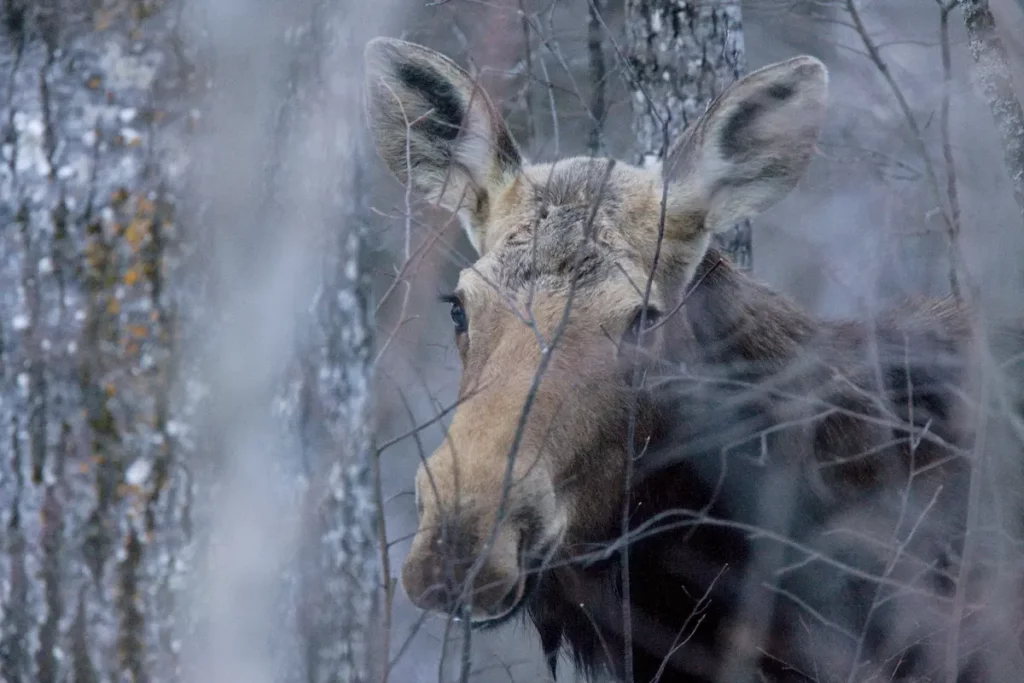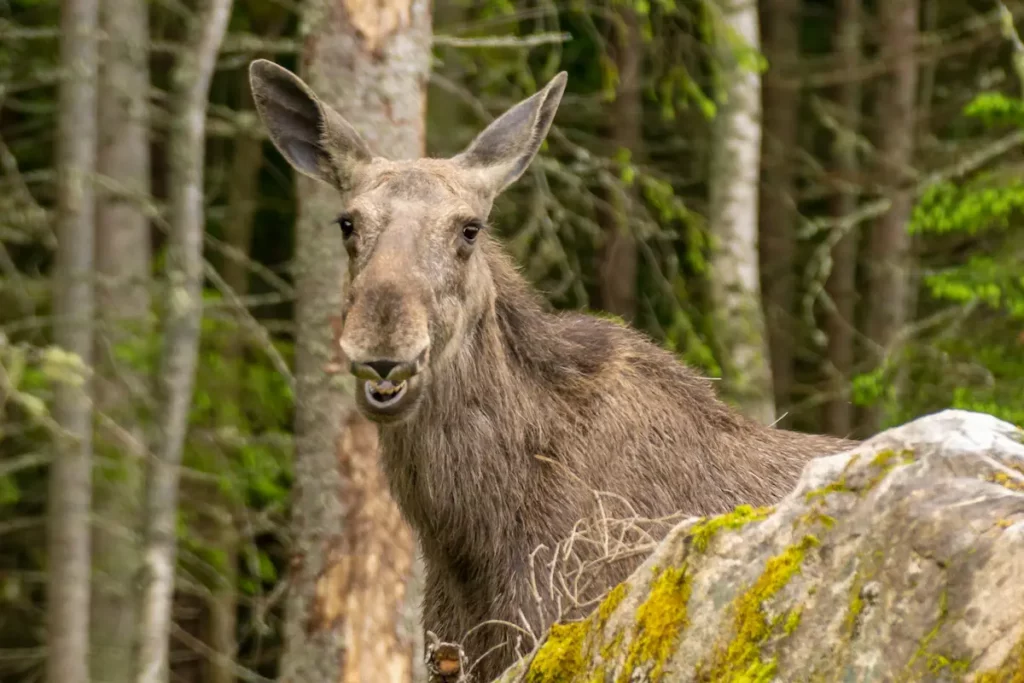It’s natural to question if riding a moose is possible, but the answer is straightforward – you can, but it’s not advisable. Even though moose are big enough to support a human, they do not have the right temperament to be ridden.
Fantasy novels and games frequently feature fantasy characters riding various imaginative and unusual-looking mounts.
Humans have a natural curiosity that drives us to imagine many animals as potential pets or mounts. This often leads us to wonder whether it is possible to ride a moose.
After considering the question, it’s doubtful that moose could make suitable steeds for riding. Has anyone attempted it? Let’s examine the reasons why this may not be a good idea.

Related Reading: Do Moose Come Out in the Rain? [FIND OUT!]
Table of Contents
Why Riding a Moose is a Challenge
They Are Aggressive
The reason why people don’t ride moose is that even though they are considered domestic animals, they are not tame and can be harmful to humans.
At times, moose can exhibit aggressive behavior.
- Mating season
- Calving season
- Any season of the year when humans annoy them.
Despite their peaceful reputation, they can attack humans who try to mount them.
It Can Be Illegal in Some Areas
As the title suggests, it is now illegal to attempt to ride a moose in certain areas.
British Columbia is one of the regions that have taken the most vital measures to prevent illegal moose riding. Still, other places are also not happy about strangers attempting to ride moose.
Keeping A Moose is an Arduous Task
Riding a moose is not an easy task, as per the researchers.
They suggest that if you want to ride a moose, you need to keep it away from its calf so that it can accept you riding it.
This challenging task requires many things to keep the moose calm and composed.
- Approximately 50 square miles to roam in
- Monstrous appetites – around 50 pounds of foliage per day
- Legal repercussions (if it is legal where you live at all)
Riding a Moose Myths
There have been many people who have considered trying to ride moose, to the extent that several urban legends about the activity have become popular over the years.
Below are some of the most interesting myths surrounding moose riding.
Swedish Moose Cavalry
Urban legend has it that the sleighs of royal couriers were pulled by moose, particularly that of Charles IX.
This is believed to have inspired Charles XI to experiment using moose to replace horses for the cavalry.
In theory, this would be perfect since there were some real benefits to a moose cavalry, including:
- Not having to import horses from across the country
- Moose were much more significant and presumably more substantial than horses.
- Moose would strike fear into the hearts of their enemies, being able to break enemy ranks without the need for artillery.
It’s likely that many of you have already realized that the idea of riding a moose never came to fruition for various reasons.
Even if it were possible to train moose to accept riders, they would be easily frightened by the sound of gunfire, making them unreliable in battle.
There were two main reasons why keeping moose was not successful.
Firstly, moose were much harder to maintain than horses due to the amount of food they consumed, the space they required to roam, and the fact that they couldn’t be fed fodder in the pasture.
Secondly, they were also more prone to disease than horses.
A commonly debated myth among historians is the tale presented here.
Alaskan Mail Carrier
There is a popular myth surrounding a mail carrier in Alaska who gained fame for having two pet moose as companions.
According to the story, he found the calves when they were around six days old and raised them as his pets, feeding them a diet of condensed milk and oatmeal.
He purportedly named the moose William and Helen, after President Taft and his daughter, respectively.
There are stories that he would use moose to help him with his work by riding on a two-wheeled cart pulled like a chariot, instead of riding the moose like a person would ride a horse.
However, there is limited historical evidence to support this claim, so it is considered to be just another story.

Russian Cavalry
In a 2010 article published by the Russian version of Popular Mechanics, it was reported that Joseph Stalin once tried to replace cavalry with moose, similar to Charles XI’s attempt.
During the Winter War of 1939 to 1940, 1,500 cavalry were trained to use moose as transportation after specially training them.
For example:
- Machine guns would be mounted to the antlers of the moose
- The animals would be trained to understand the difference between Russian and Finnish, up to an entire kilometer.
- The war would be postponed to avoid clashing with the moose mating season to ensure the steeds could be trained.
The article showed several photographs of the moose cavalry unit dressed in red army uniforms.
It is worth noting that the article in question was published on April 1st as an April Fool’s Day prank.
However, it has been circulated in various publications without the necessary disclaimer, leading to the proliferation of yet another myth about riding moose.
It is important to acknowledge that this notion is purely fictional.
Teddy Roosevelt Riding A Moose
There isn’t much to say about this topic, but there are multiple photos circulating on the internet that depict Teddy Roosevelt riding a moose.
However, a curator at Harvard University has discovered that these photographs were actually manipulated and that the 26th President had never ridden a moose.
Perhaps the President came up with the name Rough Riders from riding a moose. LOL!
Mounties Riding Moose
There has been a myth circulating online about the Royal Canadian Mounted Police riding moose instead of their horses.
However, this claim has been debunked as false.
Has Anyone Ever Ridden A Moose, Then?
There have been several hoaxes about people riding moose, but has anyone actually managed to do it?
According to the Miramichi History Museum, there is only one confirmed instance of a person successfully using a moose as a mount.
Miramichi ‘Moose Man’
At the beginning of 1900, a man named John Connell in New Brunswick found an abandoned calf in the snow.
He brought it into his barn alongside his horses and nursed it back to health.
The man named the moose Tommy and trained it to do more than just pull his sleds and sleighs.
He also taught the moose to carry a saddle and allegedly rode it like a horse.
It is believed that moose could travel more easily through the snow and cover greater distances in cold weather than horses, up to 50 miles.
In 1904, Connell gained a reputation for his knowledge of moose behavior.
The government of Newfoundland approached him to introduce a moose named Tommy to the island. There are two versions of how Tommy’s story ended.
One is a happy ending where he lived a long and peaceful life. However, it is also believed that during a shooting expedition, Connell’s brother accidentally shot Tommy.
Related Reading: Does It Hurt For Moose When They Shed Velvet?
Conclusion
To sum up, although moose are physically able to carry human weight without much difficulty, their unpredictable and aggressive nature makes them unsuitable for riding.
According to experts, even if we were to consider turning moose into suitable steeds, we would need to raise them from calves.
Raising moose can be a bad idea due to the high costs involved, the large amount of land needed, and the susceptibility of moose to diseases.
Additionally, there are legal repercussions to consider. Therefore, it is not recommended for anyone to ride moose, including postmen, police officers, soldiers, and even the president.
It’s not advisable to engage in activities that are beyond your capability or not appropriate for you.
Just like it’s unlikely for the president to ride a moose, you should also avoid doing things that are not suitable for your skills and abilities.
I hope you enjoyed the article!
Enjoy living the outdoor life!!!
